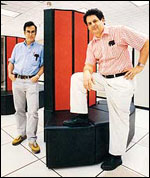|
|
|||||
|
|
PSC Celebrates 20 Years of Supercomputing in Pittsburgh
Twenty years later, the original five are three, and PSC is solidly established as one of the world's leading centers in implementing new high-performance computing technologies as productive tools for science and engineering research.
One of PSC's strengths has been its three-way collaboration between Pittsburgh's two major research universities, Carnegie Mellon University and the University of Pittsburgh, together with the technological expertise of Westinghouse Electric Company. Affiliation with two great universities helped to attract the pool of talent that has distinguished PSC, as exemplified by its flying start.
By April 1986, with a staff of a dozen people, PSC installed and tested its first system, the then state-of-the-art Cray X-MP, and it was in use by researchers only three months after ink dried on the NSF contract.
Much has changed in 20 years of supercomputing. Personal computers now have as much power as that X-MP, and PSC's newest system, the 10-teraflop Cray XT3 - named Big Ben - is more than 10,000 times as powerful. What hasn't changed is PSC's ability to get things done. Within the space of a year, Big Ben - a massively parallel system comprising 2,090 processors, much more complex than that X-MP - was tested, optimized and is now serving U.S. scientists and engineers as a production resource of the NSF TeraGrid.
Many significant results have come from research at PSC. Highlights include pioneering air-pollution studies for the Los Angeles air basin that influenced federal legislation, the first three-dimensional model of blood-flow in the heart, an accurate forecast of Comet Shoemaker-Levy 9's impact with Jupiter, modeling of earthquake soil vibration in unprecedented detail, protein modeling that contributed to the 2003 Nobel Prize in Chemistry, and development of dramatically improved ability to forecast severe storms.
PSC's staff is pleased to have had the privilege of supporting U.S scientific and engineering research for the past 20 years and looks forward to progress yet to come.
The Pittsburgh Supercomputing Center is a joint effort of Carnegie Mellon University and the University of Pittsburgh together with Westinghouse Electric Company. Established in 1986, PSC is supported by several federal agencies, the Commonwealth of Pennsylvania and private industry, and is a leading partner in the TeraGrid, the National Science Foundation's cyberinfrastructure program.
Michael Schneider |
|||
|
Carnegie Mellon Home |
|||||
